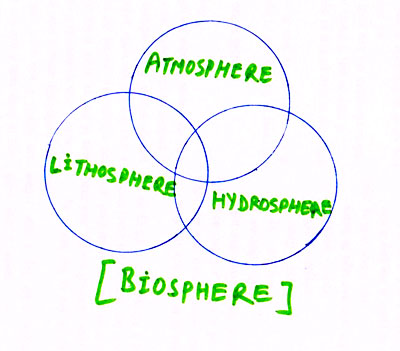(Environment & Ecology) Biosphere, Biomes, Biogeographic Realms
ENVIRONMENT AND ECOLOGY
BIOSPHERE
Earth is the only planet sustaining life forms and the space accommodating these life forms is called Biosphere. In the Levels of Organisation of such life forms, Biosphere comes at the top followed by Biomes, Ecosystem, Community, Population and individual respectively from top to bottom.
|
Biosphere → |
Biomes → |
Ecosystem → |
Community → |
Population → |
Individual |
At the global level, the surface of the earth supporting the life forms is called biosphere. It is formed through the interaction of Atmosphere, lithosphere and Hydrosphere.

Atmosphere, Lithosphere and Hydrosphere are the three main subdivisions of Biosphere. The area of contact and interaction between these components are the basic requirement for the Biosphere to exist. Living organisms are mostly confined to the area prevalent in sunlight and oxygen; this includes atmosphere, the surface of land, the few metres of soil and the upper layers water of oceans, lakes and rivers. In simple words, biosphere can be viewed as the part of the earth consisting of oceans and the surface of the continents, together with the adjacent atmosphere.
The three components of Biosphere can further be elaborated as follows:
Atmosphere: Although atmosphere is approximately 1000kms in width, but the layer which we are concerned for the study of ecosystem is only 10-15 KMs thick, i.e. Troposphere. It is of much significance to life as almost all the components serve as metabolites, and each chemical element circulates through a cycle maintaining a perpetual supply of metabolites. It is at this stage that the role of organism and significance of atmosphere to life emerge on the interface of the biospheric subdivisions.
Plants and animals undergo Photosynthesis and respiration with the help of gases of the Troposphere. Moreover, it is the sunlight prevalent through Atmosphere, which acts as catalyzing energy for living things of the earth. The green plants incorporate a variety of inorganic elements and compounds. For example, during the process of converting solar energy into chemical energy, atmosphere carbon dioxide enters the living world as the basic.
Constituent of all organic compounds. Carbon dioxide along with water is used by all plants in their photosynthetic process to produce organic substances such as, glucose a vital molecule in living things, and Oxygen similarly in respiration, the food (glucose) is broken to give the Carbon Dioxide to the environment. Carbon dioxide of the atmosphere is replenished not only through the process of respiration or biological oxidation but also through combustion of fuels and volcanic eruptions. The other important constituent in this cycle is water.
The oxygen is another very important constituent of atmosphere, necessary for the survival of ecosystem. Oxygen enters the living world through respiration which is a familiar process in both plants and animals including through it. The level of Oxygen depicts the health of any ecosystem on this planet.
Nitrogen is also an essential component of living systems. It is required by organisms for the synthesis of proteins, nucleic acids, and other nitrogenous compounds. In nature, atmospheric nitrogen is fixed by specialized organisms. There are industrial processes to convert atmospheric nitrogen into fertilizers.
Lithosphere: Geologically, Lithosphere refers to the combination of earth’s Crust and outer Mantle. It provides the platform and habitat to the biotic elements of the ecosystem. Lithosphere has two main functions with reference to the biosphere to the biosphere: 1. It provides salt or platforms for terrestrial, transitionary and aquatic plants and 2. It is the source of nutrients and minerals vital for the growth and survival of ecosystem. Depending upon its features, ecosystems are classified as Mountain, Aquatic or Desert or Mangrove.
Hydrosphere: Water is considered to be the most important constituent of biotic elements. In fact, almost all of the organisms have more than half of their constituent as water. It is inevitably required for the metabolism of living things. Moreover, plants also require it for the distribution of nutrients throughout its body. Hydrosphere refers to the water bodies like Lakes, ponds, rivers, oceans etc. on the earth surface. The surface of planet earth is occupied by more than 71% water. On a large scale water is cycled through, elements is partially used for metabolic activities and is partially excreted as waste in the environment in various forms.
BIOMES
Biomes are the major subdivision of the biosphere each recognizable by the characteristic structure of its dominant vegetation. The earth’s biomes are spread over millions of square miles and span entire continents. Each has unique climates; the average weather conditions in a given region determine the boundaries of a biome and the abundance of plants and animals found in each one. Although a biome can be considered a very large ecosystem, it differs from ecosystem such as a pond or a patch of woodland in its complexity and internal variations.
BIOGEOGRAPHIC REALMS
Biosphere has also been divided in different Bio-geographical Realms at sub-global levels. Bio-geographic realms are large spatial regions within which ecosystems share a broadly similar biological evolutionary history. Assessing biodiversity at the level of bio-geographic realms is important because the realms display substantial variation in the extent of change, they face different drivers of change, and there may be differences in the options for mitigating or managing the drivers. Terrestrial bio-geographic realms reflect freshwater biodiversity patterns reasonably well, but marine bio-geographic realms are poorly known and largely undefined. Realm divisions are based on three basic patterns:
1. Nearly all taxon are endemic or restricted to particular areas.
2. Certain kinds of organisms tend to occur together providing a basis for dividing the earth into regions.
3. Similar kinds of morphology in plants and animals occur in widely separate regions (i.e. unrelated animals and plants evolve to look alike). These animals share different evolutionary histories but have evolved similar adaptations (convergence or convergent evolution).
data-matched-content-ui-type="image_card_stacked"
Useful Tips & Articles
तैयारी कैसे करें? |
EXAM SUBJECTS |
STUDY RESOURCESDownload Free eBooks |



